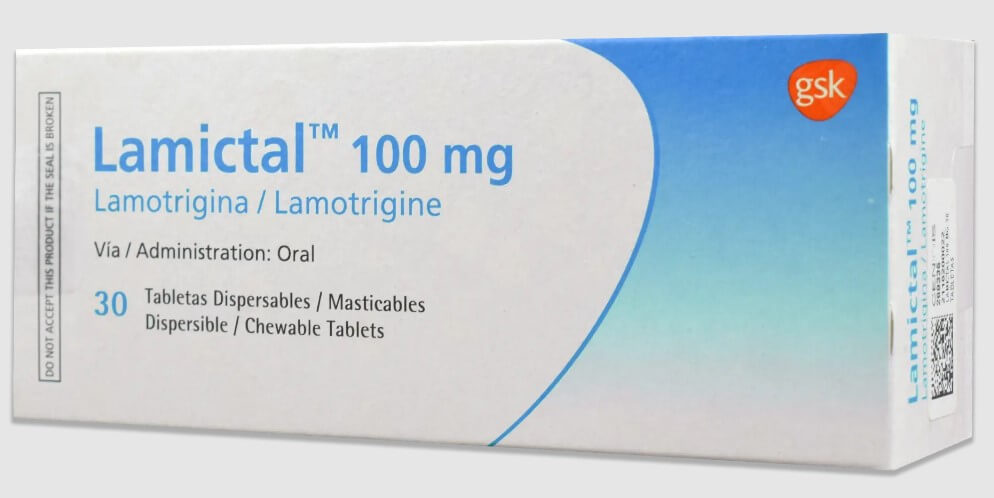Lamictal (generic name: lamotrigine) works by stabilizing the electrical activity in the brain, which can help prevent seizures and mood swings.
Antiepileptic
It is prescribed as adjunctive (add-on) therapy for patients two years of age and older suffering partial or primary generalized tonic-clonic seizures, and the severe condition characterized by recurrent seizures in babies known as Lennox-Gastaut syndrome.
Lamotrigine is often used in combination with other antiepileptic drugs to better control seizures including valproic acid, carbamazepine, phenytoin, and topiramate
Lamictal comes in two forms – immediate-release (LTG-IR) and extended-release (LTG-XR). Switching from LTG-IR to LTG-XR can help improve seizure control in some individuals with drug-resistant epilepsy, in addition to improving tolerability.
Antidepressant
Lamotrigine is commonly used to treat Bipolar Disorder type 1. People with bipolar type 1 have episodes of depression and hypomania. Lamotrigine has been found to be effective in reducing symptoms of depression in adolescents and adults with bipolar disorder. It is usually prescribed as an adjunct to drugs such as lithium, which are used to control manic phases of bipolar I disorder.
Unlike some other medications used to treat bipolar disorder, lamotrigine does not typically cause weight gain, which can be the case with other antidepressants in young patients. A specific benefit of using lamotrigine along with lithium to treat bipolar disorder in younger patients is that the drug has been shown to have a protective effect against suicidal behavior. This may be necessary because the other medications have been associated with an increased risk of suicide.
Lamictal has a relatively low risk of causing side effects, but these need to be followed carefully as they may be indicators of more serious effects. Common side effects of lamotrigine include
- Headaches
- Feeling unexpectedly drowsy, sleepy or dizzy
- Feelings of aggression, irritability or agitation
- Shaking or tremors
- Difficulty sleeping
- Diarrhea
- Nausea or vomiting
- Mild skin rash.
These side effects are generally mild and go away on their own. If they persist or get work, consult soon with your healthcare provider or pharmacist.
There have been rare reports of a serious, life-threatening skin rash known as Stevens-Johnson syndrome. It can start with flu-like symptoms, followed by a painful rash that spreads and blisters. This must be treated as an emergency and the person should be taken to an emergency clinic together with the medication history to enable rapid diagnosis and treatment.
The FDA has issued a warning that Lamictal can in rare cases cause aseptic meningitis. The main symptoms of aseptic meningitis are fever, neck pain or stiffness, photophobia, headache, nausea or vomiting and perhaps altered mental status. If such symptoms present together and persits, it is essential to stop treatment and go immediately to an emergency healthcare facility with details of the medications being taken.
Lamictal has three main uses:
- As an adjective therapy for young epileptic patients two years of age and older suffering partial or primary generalized tonic-clonic seizures, and the severe condition known as Lennox-Gastaut syndrome.
- As a monotherapy for epileptic patients 13 years and older. Treatment of epilepsy with a single drug has many advantages, such as fewer adverse events and better tolerability, avoidance of drug interactions, reduced treatment costs, and improved compliance. Monotherapy is usually the preferred initial treatment for adults.
- To treat depression in adults and teenagers over the age of 16 diagnosed with bipolar I disorder (also known as manic-depressive disorder). This disorder is a form of mental illness in which a person displays periods of abnormally elevated or irritable moods, in a cycle with episodes of deep depression. Manic episodes in bipolar I disorder require treatment with drugs, such as mood stabilizers and antipsychotics like Lithium (Eskalith, Lithobid). Lamictal is especially effective in treating or preventing manias or depressions.
Lamictal comes in two forms – either in extended-release (LTG-XR) form, which is good for long-term maintenance, or immediate release lamotrigine (LTG-IR), when the patient’s levels of depression are deep, or the threat of suicide becomes more real.
Dosage
Lamictal brand pill comes in a chewable tablet in strengths from 5 mg up to 200 mg, or generic Lamogine in 100 mg tablets. The prescribing healthcare professional will select the appropriate form and dosage.












